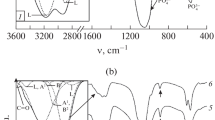Abstract
Carbonated hydroxyapatites were formed via reactions in NaHCO3/NaH2PO4 solutions from a mixture of particulate tetracalcium phosphate (TetCP) and anhydrous dicalcium phosphate (DCPA). Reactions were followed by determinations of pH and ion concentrations. The solids formed were analyzed by XRD and FTIR. Rates of heat evolution were established by isothermal calorimetry. Reactions in the absence of NaH2PO4 did not reach completion within 24 h. Constitution of reactants to achieve a DCPA-to-NaHCO3 ratio of 1, in conjunction with the presence of NaH2PO4 as a buffer, was found to be optimal for formation of apatite with no remaining reactant. The amount of carbonate incorporated in this apatite was 4–5 wt%. Calorimetry indicated the reaction mechanism to depend on the bicarbonate concentration in solution. The presence of NaH2PO4 was found to increase the reaction rate but decrease the extent of carbonate uptake.







Similar content being viewed by others
References
LeGeros RZ. Calcium phosphates in oral biology and medicine. Basel: Karger; 1991.
Nelson DGA. The influence of carbonate on the atomic-structure and reactivity of hydroxyapalite. J Dent Res. 1981;60:1621–9.
Vignoles M, Bonel G, Holcomb DW, Young RA. Influence of preparation conditions on the composition of Type-B carbonated hydroxyapatite and on the localization of the carbonate ions. Calcif Tissue Int. 1988;43:33–40.
Rey C, Collins B, Goehl T, Dickson IR, Glimcher MJ. The carbonate environment in bone mineral: a resolution-enhanced Fourier-transform infrared-spectroscopy study. Calcif Tissue Int. 1989;45:157–64.
Elliot JC. Structure and chemistry of the apatites and other calcium orthophosphates. Amsterdam: Elsevier; 1994.
Gibson IR, Bonfield W. Novel synthesis and characterization of an AB-type carbonate-substituted hydroxyapatite. J Biomed Mater Res. 2002;59:697–708.
Greish YE, Brown PW. Phase evolution during the formation of stoichiometric hydroxyapatite at 37.4°C. J Biomed Mater Res Appl Biomater. 2003;67B:632–7.
Martin RI, Brown PW. Aqueous formation of hydroxyapatite. J Biomed Mater Res. 1997;35:299–308.
Brown PW, Hocker N, Hoyle S. Variations in solution chemistry during the low-temperature formation of hydroxyapatite. J Am Ceram Soc. 1991;74:1848–54.
Martin RI, Brown PW. Formation of hydroxyapatite in serum. J Mater Sci: Mater Med. 1994;5:96–102.
Miyamoto Y, Toh T, Ishikawa K, Yuasa T, Nagayama M, Suzuki K. Effect of added NaHCO3 on the basic properties of apatite cement. J Biomed Mater Res. 2001;54:311–9.
Martin RI, Brown PW. Mechanical-properties of hydroxyapatite formed at physiological temperature. J Mater Sci: Mater Med. 1995;6:138–43.
Demaeyer EAP, Verbeeck RMH. Possible substitution mechanism for sodium and carbonate in calciumhydroxyapatite. Bull Soc Chim Belg. 1993;102:601–9.
Martin RI, Brown PW. Hydration of tetracalcium phosphate. Adv Cement Res. 1993;5:119–25.
Barralet J, Best S, Bonfield W. Carbonate substitution in precipitated hydroxyapatite: an investigation into the effects of reaction temperature and bicarbonate ion concentration. J Biomed Mater Res. 1998;41:79–86.
LeGeros RZ, Trautz OR, Legeros JP, Klein E. Apatite crystallites: effects of carbonate on morphology. Science. 1967;155:1409–11.
Fulmer MT, Brown PW. Effects of Na2HPO4 and NaH2PO4 on hydroxyapatite formation. J Biomed Mater Res. 1993;27:1095–102.
Apfelbaum F, Diab H, Mayer I, Featherstone JDB. An FTIR study of carbonate in synthetic apatites. J Inorg Biochem. 1992;45:277–82.
Krajewski A, Mazzocchi M, Buldini PL, Ravaglioli A, Tinti A, Taddei P, et al. Synthesis of carbonated hydroxyapatites: efficiency of the substitution and critical evaluation of analytical methods. J Mol Struct. 2005;744:221–8.
Author information
Authors and Affiliations
Corresponding author
Rights and permissions
About this article
Cite this article
Sturgeon, J.L., Brown, P.W. Effects of carbonate on hydroxyapatite formed from CaHPO4 and Ca4(PO4)2O. J Mater Sci: Mater Med 20, 1787–1794 (2009). https://doi.org/10.1007/s10856-009-3752-y
Received:
Accepted:
Published:
Issue Date:
DOI: https://doi.org/10.1007/s10856-009-3752-y



